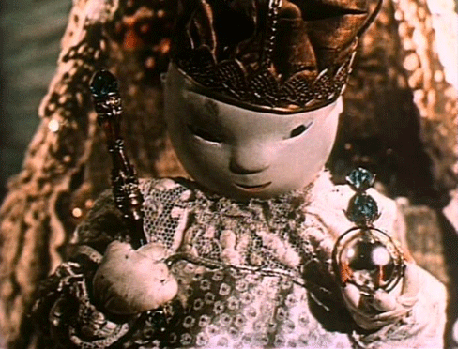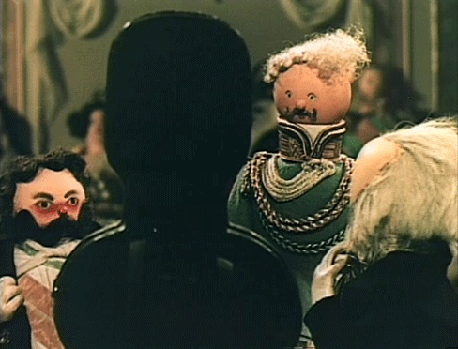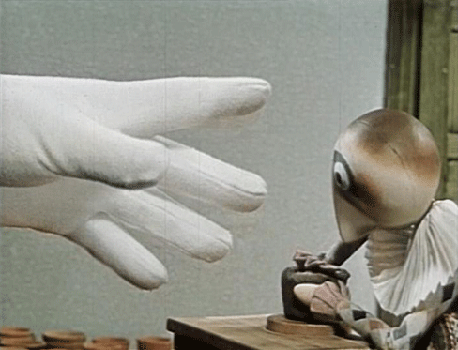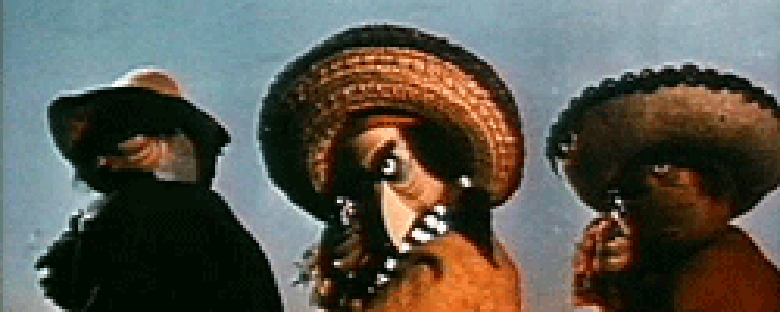Credits
Feature by: Adam Balz
Posted on: 17 June 2007
Related articles:
Features: What is Animation?
“Trnka—the name is the sum of childhood and poetry.”
—Jean Cocteau
Known to many as the Walt Disney of Europe – a denigrating title that has also haunted animators like Hayao Miyazaki (“The Walt Disney of Japan”) and Will Vinton (“The Walt Disney of Clay Animation”) – Jiri Trnka’s cinematic output seems minimal compared to that of his American counterpart, with less than thirty films to his credit when he died of heart trouble in 1969. Yet his oeuvre is remarkable in that every film is thoroughly and completely his. He was a director, writer, cinematographer and art director, set and costume designer, craftsman and animator, puppeteer. Now, with many of his works restored and available on DVD, this long-forgotten master of stop-motion animation has experienced a small but notable resurgence in critical praise and popularity.
Born in 1912 in Bohemia, Jiri Trnka (pronounced “Yershy Trinka”) was introduced to the art of puppetry almost immediately by his mother, a seamstress who made Trnka’s first playthings out of rags; likewise, Trnka’s grandmother made and sold toys to help the family financially. Soon, Trnka was more focused on the “little theatre” than his studies, which forced his parents to pull him from school and thrust him into the workforce; he apprenticed as a pastry cook and, later, a locksmith before turning to his real love.
While his interest in puppetry was unquestionably his first passion, Trnka supported himself as an illustrator. From 1937 until his death, Trnka brought to life more than fifty novels, children’s tales, and story collections with vibrant pencil sketches, water-colors, oils and inks. His most popular works were for the stories of Hans Christian Andersen, in which his illustrated men sport cotton-white beards, formed faces, and thickset eyes; his women, on the other hand, model flowing wardrobes, long locks of hair, and dainty, almost overexaggerated features. As Jaroslav Bocek points out in his 1963 biography, Jiri Trnka: Artist and Puppet Master, “By painting the dreamlike aspects of reality Trnka was doing the same as the surrealists, but his illustrations have none of the cruelty or artistic ruthlessness of surrealism. His roaming brush reflected a child’s roaming mind, with its inability to concentrate, its tendency to fantasy.”
But where Trnka’s illustrations were geared towards children, his puppet theatre was intended for adults. Which is perhaps why his first attempts at staging plays with puppet actors and actresses, Among the Fireflies, failed miserably. After working for acclaimed artist Josef Skupa since the age of 11 and taking ownership of the Wooden Theatre at age 24, he offered Among the Fireflies, his first independent play, free to school-children. Within months, and with only one great success to his name—a praised “publicity stunt” entitled Basil and the Bear—the Wooden Theatre closed, and Trnka took to illustrating for a steady salary.
The problem, Bocek admits, was that Trnka had focused too much on art and product rather than presentation; he’d offered adolescent children beautiful, hollow theatre—when the novelty of the aesthetic faded, nothing remained aside from “a shell.” That would change when, encouraged by both the Prague Uprising and a promising medium known as cinema, Trnka made his first animated film, Grandpa Planted a Beet. Though initially planned as a puppet film, Trnka decided instead to design one-dimensional characters for what would become a stepping stone in post-revolution Czech culture.
The critics couldn’t help but think of Walt Disney, only they saw Trnka as someone who could succeed in combating Disney’s monopoly over animation. From Bocek’s biography:
Walt Disney had, in fact, dominated animated cartoons throughout the thirties. It was not only that the market was flooded with films from his own studios, but also that he had influenced the technique and style all over the world. A cartoon film was automatically thought of as a Disney film, and any work in Europe in this field was always along his lines….Then came Trnka and the Trick Brothers. Years later, Stephen Bosustow, the American critic, was to call Trnka ‘the first rebel against Disney’s omnipotence.’
Disney’s omnipotence had helped other animators to learn the basic elements of the craft. His cartoons had given them technique and skill. But what they lacked was a style and concept of their own. These Trnka was to supply in his very first film, made immediately after the war.
The Czech Year, which began as an experimental film to “test the potentialities of the new techniques” in cinematic animation, became Trnka’s first puppet feature. It also marked the first collaboration of Trnka and composer Vaclav Trojan on a puppet film. Having met in Prague, Trojan remained Trnka’s loyal composer until the director’s very last film. Most critics today now credit Trojan with adding much of the charm and cinematic brilliance to Trnka’s films. From the dominant musical themes of The Story of the Bass Cello to the natural sounds found in The Devil’s Mill and the near claustrophobic sounds of The Hand, Trojan knew perfectly how to compliment Trnka’s style.
The Czech Year, an immediate international success, also garnering Trnka immense praise, and allowed him to create what would become one of his most memorable features: The Emperor’s Nightingale.

THE EMPEROR’S NIGHTINGALE (1949)
Based on the story by Hans Christen Andersen, Jiri Trnka’s The Emperor’s Nightingale opens with the soft, irregular stammer of a piano. As the camera moves back, we’re offered a small boy engaged in practice. Around him, bundles of toys are the child’s surrogate companions. The boy is living with two old aunts while his father travels the world, and his new home, a Victorian mansion, is surrounded by gates and governed by rules. There is no stepping on the grass, no playing with strangers, no going outside the estate walls. The boy lives an affluent life but is miserable. This is his birthday; his father has sent a present from China, his aunts have given him a cake, but he is alone. Outside, a poor girl waits at the gates for the boy to come out and play. But he doesn’t and, taking to his new toy, falls ill.
The toys are part of their own world, which unfolds in the boy’s dreams. A porcelain doll becomes the Emperor of a vast domain that, much like the boy’s home, is contained by an endless glass barrier. Every morning he arises and is dressed by servants; his life, dominated by rules, allows him only vacant moments of enjoyment. Feeding glass swans and chasing a bound butterfly in circles are the Emperor’s only means of fun, and culture comes from a large fish statue in the courtyard which, when pumped full of air, produces fragrant bubbles and unpleasant Theremin music.
One evening, a traveler lands his hot air balloon in the Emperor’s courtyard. His stay dominated by confusion and formalities—he spends much of his stopover exchanging bows with the Emperor—the traveler departs after presenting the monarch with a book of etchings. Much to the Emperor’s delight, the traveler has preserved his immense kingdom on paper. That is, all but the final illustration, a drawing of a lone gray bird—a mockingbird, they discover, though no one living within those walls knows where to find one. The Emperor, though, asks for the bird, and only a poor, petite maid knows the animal personally. After she leads them through trees and bushes and bamboo to the mockingbird’s natural home, the bird agrees to sing for the Emperor.
At first the bird brings tears to the Emperor’s eyes. But what is a beautiful gift soon becomes a secondary pleasure, a forgettable former amusement. The bird, which had been kept in an adorned cage and forced to adhere to the rules of the kingdom, flies back to him home, replaced by a mechanical mockingbird that plays the same dogged, unchanging tune from sunrise to sunset. Soon the song has made the Emperor ill, and death seems imminent. All that can spare him from Death’s grasp is the tender, true song of the living mockingbird.
Everything that makes up the Emperor’s kingdom comes from the boy’s room. A rubber ball in netting becomes the traveler’s hot air balloon. A fish figurine becomes the mammoth musical statue. A small, monotonal toy nightingale in a cage—the father’s present to his son—becomes the golden, motorized bird. Even the boy’s cymbal-clashing toy soldier, which awakens him from his dream, appears as the Emperor’s giant alarm, designed to keep him fixed to routine.
Vaclav Trojan’s music is the foundation of this film’s charm, especially in the difference between the songs of the real and mechanical nightingale. The real bird sings long, luscious tones that fill ever hall of the Emperor’s massive palace, while the manufactured bird can only repeat the same tedious, thick-toned song. And while the servants, having never stepped foot outside the kingdom walls, are overjoyed at the song of the second bird, the Emperor’s life is saved by the first, as its song moves Death to spare him. The next morning, as the Emperor rises, he abandons the habits of his former self. The servants stand astonished; the cymbal-clashing alarm becomes irate and falls apart. The boy awakens and, noticing the girl standing beyond the gates, rushes outside to play.
THE SONG OF THE PRAIRIE (1949)
“This is the Wild West, the country of the superman, where the pistol is cocked and ready at all time, and there is no room for timidity. Love blossoms at first sight.”
—Jaroslav Bocek
It is apparent almost instantly that Trnka is familiar with the films of John Ford, specifically his 1939 work Stagecoach. Trnka’s twenty-minute The Song of the Prairie begins with a musical variation of George Cohen’s “Yankee Doodle Dandy” and is focused solely on a coach bound for an unnamed destination; inside, a young woman sits silently across from an old man, unaware of the danger ahead. Along the way, they pick up a third passenger—a cloaked stranger who performs otherworldly card tricks.
The stranger is, of course, after the case of gold bound to the coach’s roof. And in keeping with the traditions of the American Western, he’s enlisted the help of four Mexican bandits. Here, they are depicted as trite throwbacks to character actors such as Alfonso Bedoya. Unshaven and sporting embellished features—bulbous noses, coppice eyebrows, faces furrowed into dales—they brandish pistols they are nearly incapable of firing accurately, thus adhering to the cinema stereotype of sore antagonistic imprecision. (Only when one of the stagecoach drivers, a character reminiscent of Thomas Mitchell’s Doc Boone in Ford’s original Western, drinks a bottle of whiskey that dribbles out three bloodless gunshot wounds, is the oversight amusingly confronted.)
The hero is, of course, a gallant and mysterious man whose arrival is both quick and convenient. Having been seen by the female passenger once before—in the film’s opening, when they sang to one another along the dusty path and exchanged tokens of love—he appears just as the Mexican bandits have begun firing on the stagecoach, sheering the elderly passenger’s beard while he sleeps and frightening the young woman into a frenzy. In a matter of seconds our hero has advanced upon the coach and shot two bandits from their horses; the third and forth monopolize his gunfire, allowing the stranger to kidnap the woman and steal the gold—all of which is done with surprising, humorous ease.
Luckily, the woman is able to break free by grabbing a tree branch, while the villain’s horse abandons him in favor of a pool of soothing water. Nearly defeated, the final showdown occurs in the mountains, where the leader of the bandits takes position on a peak; below, the hero, acting out of either confidence or stupidity, pauses to light a cigarette, allowing the villain to drop a boulder on his head. Stunned, our hero continues, and the villain crawls to another peak via a well-thrown rope. From there, the villain’s final attempt to kill the hero is thwarted when, unbeknownst to him, the fire from a lit cigar engulfs the mountaintop. He falls, tumbling, and the vultures swoop. Playing cards drift to the dusty brown ground.

STORY OF THE BASS CELLO (1949)
Story of the Bass Cello, also known as The Story of the Double-Bass, is a silent, elegant, and deftly humorous thirteen-minute film based on a short work by Anton Chekhov. The main character, Smychkov, is a bass-player who we find sitting alone at the lakeside. To his back is a large case containing his double-bass, and it towers over him—his profession towering over his life. Miserly, he decides to take a swim and, stripping off all his clothes, wades into the sheer, crystalline water. Treading, he comes upon Bibulova, a beautiful woman with a fishing pole at her side. She is asleep, and Smychkov is absorbed by her beauty. But in no state to awaken her or express his love for her, he hooks a bouquet of flowers to the end of her line and swims away.
When Smychkov returns to his double-bass, he discovers that his clothes have been stolen by a thief. Using his instrument as a screen, he makes his way to the nearby bridge. At the same time, Bibulova has awoken and taken off her clothes for a dip in the lake. Her clothes, as it happens, are also stolen, and she takes refuge in the water, where both she and Smychkov meet. Both cover their eyes, startled, knowing the other is bare. Smychkov leaves the lake, removes the double-bass from its case and offers it to her as an impromptu, if not uncomfortable and ill-fitting, shelter. When she’s securely inside, Smychkov begins on his way to a scheduled performance at a soiree, where two of his fellow musicians are awaiting his arrival.
Also waiting for Smychkov are two impatient, perfectly contrasted officials—one’s tall and lean, while the other is short and stocky—and a gallery of plain-faced men and women, all of whom remain seated or leaning with an air of angry impatience. The two musicians are dispatched to find their friend, but they only discover his hat and case; Smychkov, we know, has run off in search of the clothing thief, who eludes the nude bass-cellist in a field of corn. Confused, the two musicians carry the case back as proof of Smychkov’s disappearance. When the case is opened and the Bibulova is revealed to all assembled, the camera distorts. The angle stretches, and a red filter adds an air of lurid, embarrassed shock. The tall official falls over, stunned. The men and women of the gallery raise their arms in disbelief. But Bibulova, calm and resting, remains still, her arm draped gently over her chest, her body seemingly molded to the shape of the bass-cello case. The moment is funny yet poetic, beautiful yet startling. The moment is pure Trnka.
By the release of Story of the Bass Cello, Trnka’s critics began taking note of his films’ mature nature. This film alone depicts puppets in various forms of undress, as well as noble characters who indulge unendingly in the drink. Likewise, The Song of the Prairie contained scenes of violence, treachery, and alcoholism. Writes Bocek:
Trnka was accused of formalism, of a tendency to art pour l’art, cosmopolitanism, and a host of other artistic sins. But mainly the critics objected to the fact that his films were unsuitable for children. They said that The Story of the Double-Bass, for instance, was too sophisticated, and that The Devil’s Mill was too frightening.
This was the core of the misunderstanding that grew up around Trnka as time went on. In fact, Trnka had not intended his films for children. From the very beginning Trnka wished to attract adult audiences to the puppet film. The Czech Year and the films that followed it were intended for adults. Trnka believed the puppet capable of expressing important emotions and ideas. This had been true of puppet theatre when it was at its height: it had become entertainment for children only when it had become decadent as an art form, and this had caused a prejudice which faced anyone who tried to revive it as a serious medium of expression…. [Trnka] met repeatedly with prejudice against puppets, in the minds of people who thought they could only perform simple tales for children. He had himself achieved a great deal in this line, with his children’s book illustrations.

THE HAND (1965)
“It was much harder for the watchdogs to penetrate the land of fairy tales, folk stories, and poetic visions…”
—Antonin Liehm, Closely Watched Films
Jaroslav Bocek’s Jiri Trnka: Artist and Puppet Master, one of the few biographies of Trnka available in English (it was translated by Till Toggheiner), ends in 1964 with the release of The Cybernetic Grandma, Trnka’s portrayal of man versus technology. The very following year, he released what would be his last film: The Hand.
While not his first political satire—The Chimney Sweep, Trnka’s satire of Nazism, contained goose-stepping puppets—The Hand is Trnka’s most blatant critique of politics’ command over art. The main character, a humble and nameless artist, lives in a one-room home somewhere in Czechoslovakia. His joy of life is unmistakable; even as he awakens, his face glows and his movements are commanded by an internal sense of happiness and contentment. As we soon discover, he lives perhaps the simplest life imaginable. His home contains no television, no radio, no books or newspapers—no outside influences of any kind. The one visible window provides all necessary light, and his only tool, a pottery wheel, is operated manually. Known simply as the Artist, Trnka’s humble protagonist spends his days creating pots from clay. They vary in size; amassed in the corner of his room, they wait to be filled. Yet he’s never seen selling them. It’s as though he’s created a life for himself based on nothing more than a standard hobby.
On this very afternoon, the Artist is visited by the titular hand—a gloved, life-sized limb that enters the Artist’s house through the window. It wants the Artist to make sculptures of hands – effigies cast in blind fidelity – but the Artist refuses; when the Hand molds a raw pot into a likeness of itself, the Artist quickly changes it back. Even when the Hand sneaks a television set into the Artist’s home to broadcast propaganda, the Artist refuses to be swayed. But the Artist is eventually – and literally – seduced by a hand dressed in lace that gyrates perversely before his eyes. As he watches, puppet-strings take hold of his outstretched arms, and suddenly he’s become an instrument of government propaganda. Locked in a cage, the Artist is forced to carve a monument of the Hand from stone. He is decorated by the Hand, given a golden crown, and celebrated. The Artist, though, awakens from the persuasion and escapes.
At first glance, Trnka’s relationship with the Stalinist Czech government seems symbiotic—they allowed him to produce his films without difficulty, even christening him the National Artist in 1963, while his art remained strictly apolitical. But as Czechoslovakia became more and more Communist, the government threatened to subsidize the work of all Czechoslovakian filmmakers, Trnka included. Great directors like Jan Kadar and Elmar Klos, who garnered their nation an Academy Award in 1965, were forced to alter their intentions, their work, for the sake of survival; eventually, Kadar emigrated to the United States while Klos retired from filmmaking. Even Ladislav Helge, who celebrated his nation’s slow return to autonomy in the so-called Czechoslovakian Spring by directing Shame, has not made another film since. So what allowed Trnka the absolute and unimaginable freedom to create his films without fear of government intervention? According to author Antonin Liehm, simply this:
Artistic animated films, and above all artistic animated puppet film, is probably the least lucrative aspect of film work. Its very existence depends on public subsidies – or at least it did in the forties and fifties – especially in a small country before the boom of television… But while [the Stalinist patronage] demanded bland works of propaganda when it came to ordinary feature films, it put far less pressure to bear on animated films, in part because the very nature of animated and, particularly, puppet films is so much a matter of extreme stylization and poetization that they were difficult to harness to the heavy wagon of Stalinist political propaganda.
Trnka was saved by the very style and technique that had come to define him, as well as the genre that he loved. How could a government censor a film that had no words, no identifying visages or heads of state? How could a government censor a film based on fairy tales and old Czech legends? It couldn’t.
We don’t do comments anymore, but you may contact us here or find us on Twitter or Facebook.



